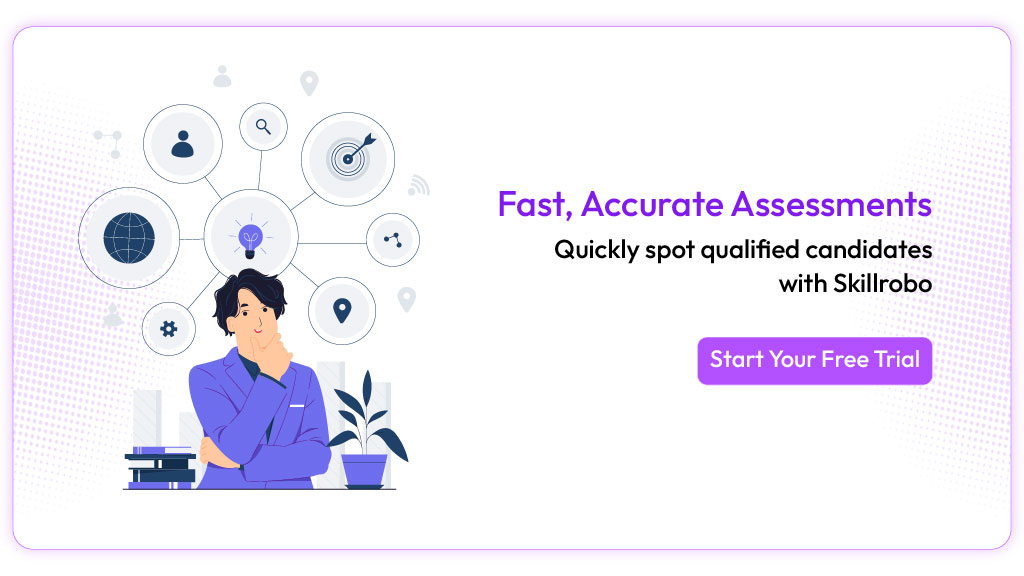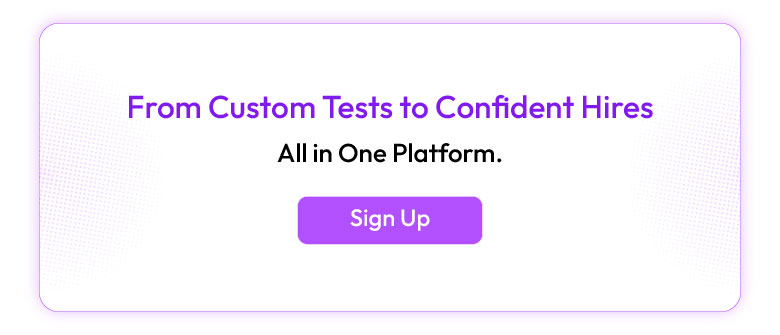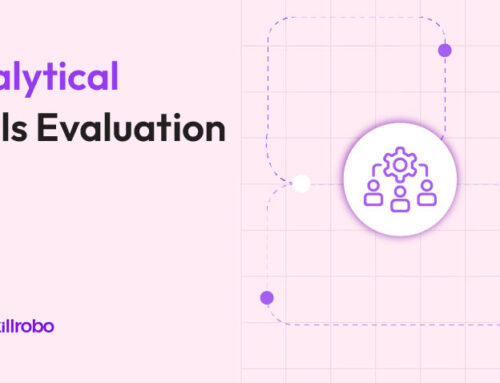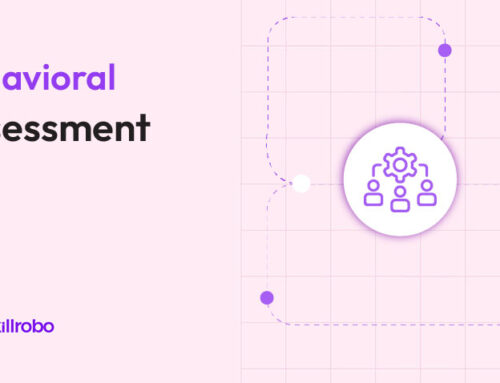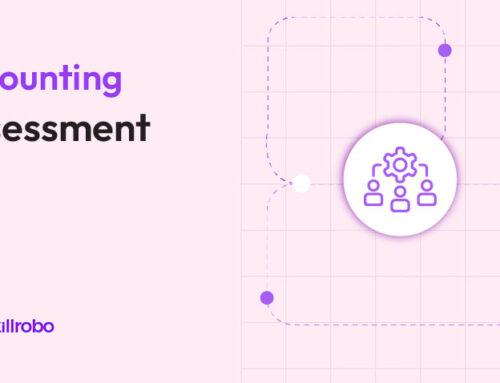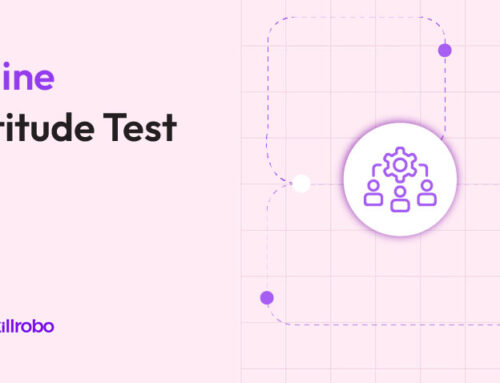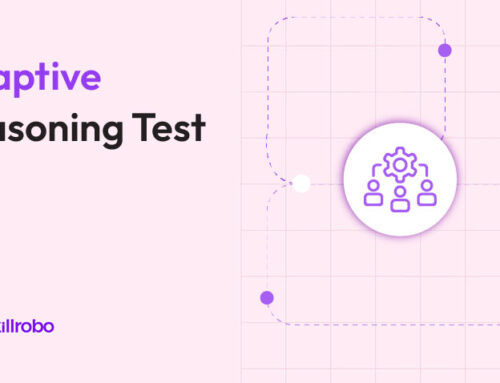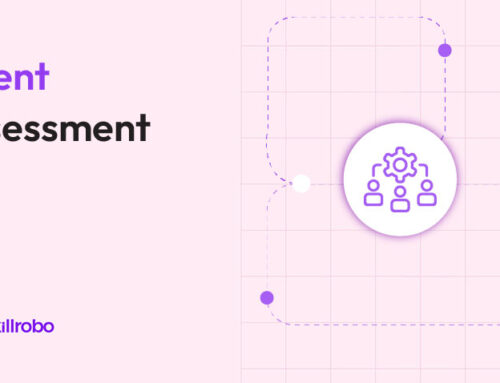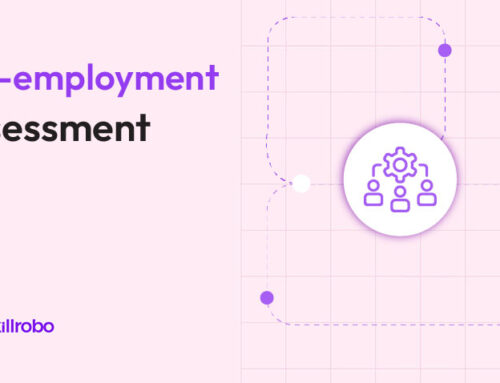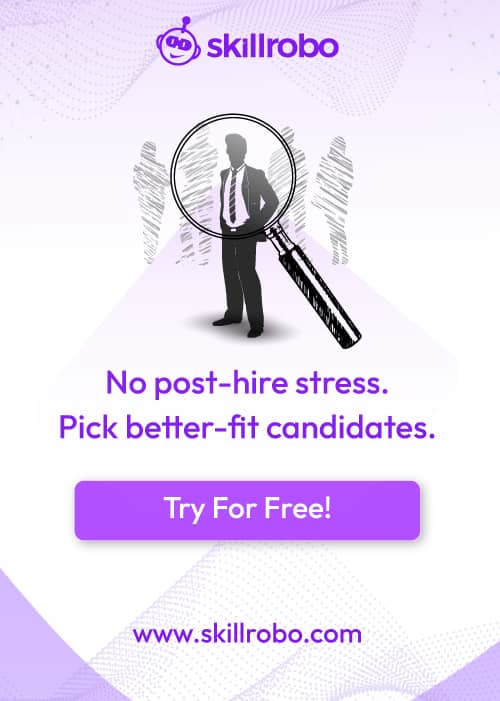Table of Contents
- Key Takeaways
- Why Talent Assessments Are Business-Critical at Scale
- What Are Talent Assessments for Enterprises?
- The Benefits of Talent Assessments for Large Companies
- Key Components of Talent Assessment Tools
- Best Practices for Large Enterprises Implementing Talent Assessments
- Strategies for Using Talent Assessments for Large Companies
- How Skillrobo Supports Talent Assessments for Enterprises
- Conclusion: Assess Talent at Scale, Strategically
Related articles
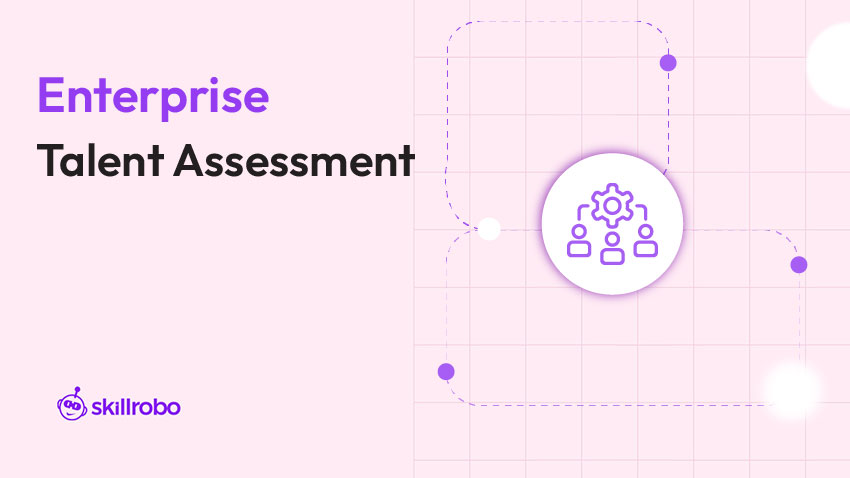
Key Takeaways
- Talent assessments for enterprises help align large-scale hiring and development efforts with business goals through structured, unbiased evaluation.
- Key components include cognitive, behavioral, and AI talent assessment tools for data-driven talent insights.
- Enterprises benefit from improved hiring accuracy, leadership development, and internal mobility through assessment strategies.
- Following best practices and structured frameworks ensures long-term ROI from enterprise-wide talent assessment programs.
Why Talent Assessments Are Business-Critical at Scale
Large organizations operate with diverse roles, geographies, and strategic goals, making talent alignment increasingly complex. As enterprises grow, their ability to consistently evaluate, hire, and develop top performers becomes critical to competitive advantage. This is where talent assessments for enterprises come into play.
By applying standardized, scalable, and data-driven assessment frameworks, enterprises can reduce hiring bias, boost retention, and strengthen internal mobility. These tools go beyond basic screening—they serve as the foundation for leadership development, workforce planning, and business continuity. In this blog, we explore what talent assessments for enterprises are, their key components, benefits, and how large companies can implement them effectively.
What Are Talent Assessments for Enterprises?
Talent assessments for enterprises are structured evaluations used to measure skills, behaviors, cognitive ability, and potential at scale. Unlike one-off hiring tools, these assessments are embedded into the full employee lifecycle, supporting hiring, promotion, upskilling, and workforce strategy.
Designed for high-volume usage and diverse role types, enterprise assessments typically include modules for technical skills assessment, personality profiling, and AI-driven predictive analytics. When used correctly, they enable strategic alignment between business objectives and workforce capability.
For example, a global IT firm used AI talent assessment tools to restructure its hiring across 12 countries. The result was a 40% reduction in time-to-hire and a 23% increase in post-hire retention.
The Benefits of Talent Assessments for Large Companies
Implementing talent assessments for large companies provides both immediate and long-term value by supporting data-driven decision-making across the entire employee lifecycle. From hiring to leadership development and workforce planning, assessments offer measurable improvements in quality, consistency, and strategic alignment. Here are the most notable benefits:
1. Reduced Bias and More Inclusive Hiring
Traditional hiring methods often rely on resumes, interviews, and personal impressions, which can introduce unconscious bias. Enterprise-wide assessments introduce standardized evaluations, ensuring that every candidate is measured against the same criteria. By leveraging structured pre-employment assessment tools, organizations can create a more equitable and inclusive hiring process. This not only improves diversity but also helps uncover high-potential candidates from non-traditional backgrounds who may have otherwise been overlooked.
2. Improved Hiring Accuracy
Hiring mistakes are costly, especially at scale. With advanced skill assessment tests, recruiters can objectively verify whether a candidate possesses the required competencies for the role before making an offer. These assessments go beyond surface-level indicators, such as education or previous job titles, and focus on real job performance predictors. The result is better role alignment, reduced early attrition, and a more efficient recruitment process.
3. Stronger Leadership Pipelines
One of the most strategic uses of talent assessments for enterprises is identifying high-potential talent within the organization. Behavioral and cognitive assessments provide valuable insights into leadership capabilities, decision-making styles, and growth potential. By integrating these tools into talent development programs, companies can build robust internal pipelines that support talent mobility and succession planning. This reduces the need for external hires and strengthens organizational continuity.
4. Data-Driven Workforce Planning
Large enterprises need reliable data to make informed workforce decisions. Talent assessments generate rich insights into individual and team-level skills, competencies, and gaps. This information can be used to plan training initiatives, restructure teams, and allocate resources more effectively. In particular, structured employee skills assessment initiatives enable businesses to respond quickly to evolving industry demands by developing the right capabilities at the right time.
5. Enhanced Productivity and Retention
Employees who are well-matched to their roles tend to perform better and stay longer. Talent assessments help place individuals in positions that align with their strengths, preferences, and long-term potential. Structured employment assessment tests ensure that fit is evaluated objectively, before and after hiring, leading to increased engagement and fewer performance issues.
Key Components of Talent Assessment Tools
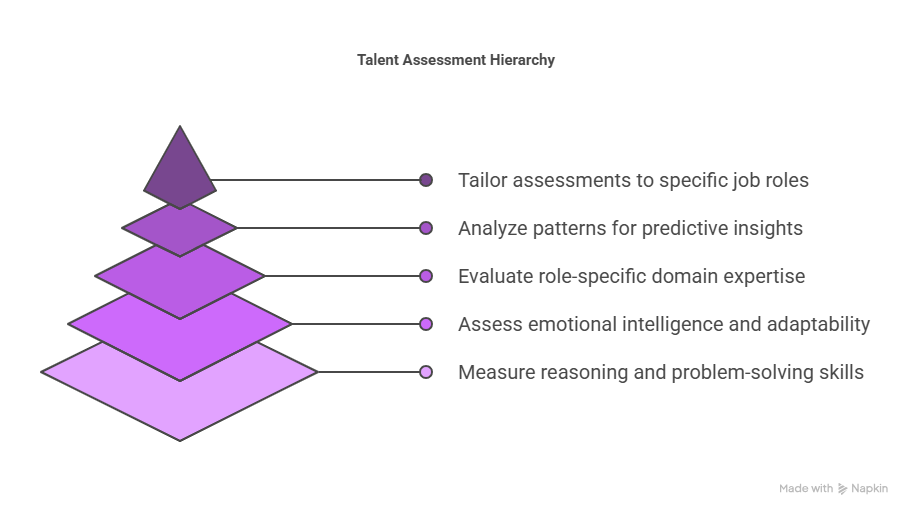
An effective enterprise-grade talent assessment platform goes far beyond basic testing. It incorporates diverse evaluation mechanisms, integrates with existing systems, and scales effortlessly across departments, geographies, and job roles. The following components form the backbone of high-impact, comprehensive talent assessment tools used by large organizations:
1. Cognitive Assessments
These assessments measure reasoning, problem-solving ability, logical thinking, and numerical aptitude. They are especially valuable for identifying individuals who can process complex information, think critically, and adapt quickly—traits vital in leadership, strategy, and high-stakes roles. In large enterprises, cognitive assessments help screen and rank thousands of applicants consistently, ensuring that high-potential talent isn't overlooked during the selection process.
2. Behavioral & Personality Tests
Understanding how individuals behave in team settings or under pressure is key to building collaborative, resilient organizations. Behavioral and personality tests assess traits like emotional intelligence, adaptability, communication style, and stress tolerance. These insights are vital when hiring for team-based roles, client-facing positions, or leadership pipelines. In large companies, such tools support long-term talent management by ensuring cultural alignment and minimizing interpersonal conflicts.
3. Technical Skills Evaluation
These are role-specific tests that measure domain expertise, such as programming, data analysis, accounting, or digital marketing. Enterprises rely on skill assessment tools to ensure candidates and employees possess the technical knowledge required to succeed. Unlike resumes or interviews, these assessments provide objective proof of capability, enabling companies to scale tech hiring, monitor upskilling progress, and identify experts internally for high-priority projects.
4. AI-Driven Analytics
Modern platforms now leverage AI talent assessment capabilities to go beyond scoring. AI analyzes response patterns, prediction models, and engagement levels to generate deeper insights, like future performance probability, risk of attrition, or hidden strengths. These predictive analytics empower HR and business leaders to make strategic decisions based on data, not instinct. AI also enables real-time feedback loops, personalized learning recommendations, and process automation.
5. Role-Based Assessment Design
One-size-fits-all assessments are ineffective in enterprise environments where roles differ vastly in skill sets and expectations. Role-based assessment design ensures that each evaluation is tailored to specific job functions, seniority levels, and team dynamics. Whether it's for a junior software engineer or a regional sales head, the customization improves accuracy, candidate experience, and decision-making outcomes. This component also enables consistent benchmarking across departments and geographies.
Together, these components enable talent assessments for enterprises to scale with organizational growth, enhance decision-making, and support every stage of the employee journey—from hiring and onboarding to development and succession.
Best Practices for Large Enterprises Implementing Talent Assessments
For large organizations, rolling out a talent assessment strategy at scale involves more than just selecting a tool—it requires careful planning, alignment with business goals, and ongoing optimization. These best practices ensure that talent assessments for enterprises deliver measurable impact and long-term value.
1. Align Assessments with Strategic Goals
The first step to successful implementation is defining the why. Are you focused on hiring speed, improving diversity, identifying leadership potential, or reskilling existing teams? Clarifying these priorities ensures that the selected talent assessment tools align with organizational objectives. For instance, a company prioritizing innovation may need assessments tailored to cognitive agility and creativity, whereas a regulated industry might focus on compliance and attention to detail.
2. Integrate with HR Tech Stack
For seamless data flow and reporting, your assessment platform should integrate with your existing HR ecosystem, including ATS (Applicant Tracking Systems), LMS (Learning Management Systems), and employee evaluation software. This integration ensures that assessment results feed directly into employee records, enabling real-time insights, performance tracking, and better-informed development plans. It also reduces manual effort and ensures consistency across departments and regions.
3. Use Pilot Programs
Before deploying assessments across the organization, run a pilot in one department or business unit. This controlled launch allows your team to test the tool's functionality, collect feedback from users, and identify any challenges early. Pilots provide valuable insight into usability, reporting clarity, and cultural fit, ensuring smoother, faster adoption when scaled company-wide.
4. Train Stakeholders
Talent assessments generate rich insights, but their value depends on proper interpretation. HR teams, line managers, and interview panels must be trained to understand assessment reports, identify actionable patterns, and give constructive feedback. This builds confidence in the process, increases user adoption, and ensures that assessment results translate into better hiring and talent decisions.
5. Maintain Data Privacy and Compliance
Large enterprises often operate in multiple countries, each with its own set of labor laws and data protection regulations. Whether it's GDPR in Europe or CCPA in California, compliance must be built into your assessment workflows. Choose a platform that prioritizes data security, encryption, and consent management. Ensure both internal HR teams and vendors are aligned on data storage, access, and audit processes.
Following these best practices allows enterprises to implement talent assessments not as a standalone HR initiative, but as a critical component of workforce strategy—empowering smarter hiring, stronger development, and long-term business growth.
Strategies for Using Talent Assessments for Large Companies
To extract maximum value from talent assessments for large companies, enterprises must go beyond implementation and embed assessments into ongoing HR and business processes. When thoughtfully integrated, these assessments become strategic levers for performance, development, and organizational alignment.
1. Continuous Learning Loops
Many organizations limit assessments to pre-hire screening, but leading enterprises treat them as ongoing tools for development. Conducting assessments at regular intervals—such as annually or after completing major projects—helps track skill progression and identify learning needs. These insights enable L&D teams to personalize upskilling initiatives, prioritize training budgets, and support talent mobility by mapping employee readiness for new roles. This creates a feedback-rich culture that supports continuous growth and agility.
2. Combine Pre-Hire and Post-Hire Assessments
Enterprises should not silo assessments into recruiting alone. By evaluating both prospective and existing employees, organizations gain a full picture of workforce capability. Pre-employment assessment tools help ensure quality at entry, while post-hire evaluations uncover areas for growth and advancement. Together, this dual approach supports end-to-end talent lifecycle management—helping HR leaders manage current needs and plan for future roles.
3. Integrate Feedback into Performance Reviews
Integrating assessment data, such as scores from skills assessment test platforms, into performance appraisals adds objectivity and consistency to reviews. Managers can use the data to guide conversations around strengths, improvement areas, and career paths. This not only enhances employee trust in the review process but also supports fair, data-backed promotions and compensation decisions across the enterprise.
4. Centralize Data for Strategic Decision-Making
Large companies often struggle with fragmented talent data. By centralizing talent assessment results within an integrated HR system or talent analytics dashboard, organizations can merge them with metrics like engagement, retention, and productivity. This unified view provides executives and HR leaders with actionable workforce intelligence, enabling better decisions around hiring plans, team composition, succession strategies, and workforce investments.
By adopting these strategies, large companies can position talent assessments as a cornerstone of workforce planning, not just a hiring tool. The result is a more informed, agile, and development-driven organization prepared to adapt and grow in a constantly evolving business environment.
How Skillrobo Supports Talent Assessments for Enterprises
Skillrobo is an AI-powered platform designed to simplify and scale talent assessments for enterprises. Built for modern HR teams, Skillrobo enables organizations to evaluate candidates and employees with precision, speed, and consistency across global teams and diverse job roles.
With Skillrobo, enterprises can create role-specific assessments that evaluate technical, behavioral, and cognitive competencies using customizable test formats. Whether you're screening high-volume applicants or identifying future leaders, Skillrobo provides data-backed insights to support every talent decision, while ensuring compliance and consistency.
Key Features:
- Custom Role-Based Assessments – Create tailored evaluations aligned with job requirements and department goals.
- AI Talent Assessment Engine – Predict performance and flag potential risks with AI-driven insights and analytics.
- Integrated Platform – Seamlessly connect with ATS, HRIS, and employee evaluation software for smooth data flow.
- Global Scalability – Deploy assessments across regions, departments, and job levels with localization support.
- Real-Time Reporting Dashboards – Visualize performance data, benchmarking, and skills insights instantly.
Skillrobo also supports enterprise efforts in talent mobility, leadership development, and internal benchmarking. By leveraging tools like skill assessment tests and behavioral evaluations, HR leaders gain a comprehensive understanding of both new and existing talent
Conclusion: Assess Talent at Scale, Strategically
For large enterprises, scaling talent strategies without losing consistency or accuracy is a constant challenge. By adopting structured talent assessments for enterprises, organizations can bring clarity, precision, and fairness into every talent decision, from hiring to leadership development.
With the help of AI talent assessment tools and best practices, HR leaders can transform assessments from a checkbox activity into a long-term competitive advantage. The future of enterprise workforce strategy lies in measurable, actionable insight, powered by intelligent assessment systems.
Looking to streamline enterprise-level talent assessments? Sign up for Skillrobo and make your workforce decisions faster, smarter, and more strategically.

Key Takeaways
- Talent assessments for enterprises help align large-scale hiring and development efforts with business goals through structured, unbiased evaluation.
- Key components include cognitive, behavioral, and AI talent assessment tools for data-driven talent insights.
- Enterprises benefit from improved hiring accuracy, leadership development, and internal mobility through assessment strategies.
- Following best practices and structured frameworks ensures long-term ROI from enterprise-wide talent assessment programs.
Why Talent Assessments Are Business-Critical at Scale
Large organizations operate with diverse roles, geographies, and strategic goals, making talent alignment increasingly complex. As enterprises grow, their ability to consistently evaluate, hire, and develop top performers becomes critical to competitive advantage. This is where talent assessments for enterprises come into play.
By applying standardized, scalable, and data-driven assessment frameworks, enterprises can reduce hiring bias, boost retention, and strengthen internal mobility. These tools go beyond basic screening—they serve as the foundation for leadership development, workforce planning, and business continuity. In this blog, we explore what talent assessments for enterprises are, their key components, benefits, and how large companies can implement them effectively.
What Are Talent Assessments for Enterprises?
Talent assessments for enterprises are structured evaluations used to measure skills, behaviors, cognitive ability, and potential at scale. Unlike one-off hiring tools, these assessments are embedded into the full employee lifecycle, supporting hiring, promotion, upskilling, and workforce strategy.
Designed for high-volume usage and diverse role types, enterprise assessments typically include modules for technical skills assessment, personality profiling, and AI-driven predictive analytics. When used correctly, they enable strategic alignment between business objectives and workforce capability.
For example, a global IT firm used AI talent assessment tools to restructure its hiring across 12 countries. The result was a 40% reduction in time-to-hire and a 23% increase in post-hire retention.
The Benefits of Talent Assessments for Large Companies
Implementing talent assessments for large companies provides both immediate and long-term value by supporting data-driven decision-making across the entire employee lifecycle. From hiring to leadership development and workforce planning, assessments offer measurable improvements in quality, consistency, and strategic alignment. Here are the most notable benefits:
1. Reduced Bias and More Inclusive Hiring
Traditional hiring methods often rely on resumes, interviews, and personal impressions, which can introduce unconscious bias. Enterprise-wide assessments introduce standardized evaluations, ensuring that every candidate is measured against the same criteria. By leveraging structured pre-employment assessment tools, organizations can create a more equitable and inclusive hiring process. This not only improves diversity but also helps uncover high-potential candidates from non-traditional backgrounds who may have otherwise been overlooked.
2. Improved Hiring Accuracy
Hiring mistakes are costly, especially at scale. With advanced skill assessment tests, recruiters can objectively verify whether a candidate possesses the required competencies for the role before making an offer. These assessments go beyond surface-level indicators, such as education or previous job titles, and focus on real job performance predictors. The result is better role alignment, reduced early attrition, and a more efficient recruitment process.
3. Stronger Leadership Pipelines
One of the most strategic uses of talent assessments for enterprises is identifying high-potential talent within the organization. Behavioral and cognitive assessments provide valuable insights into leadership capabilities, decision-making styles, and growth potential. By integrating these tools into talent development programs, companies can build robust internal pipelines that support talent mobility and succession planning. This reduces the need for external hires and strengthens organizational continuity.
4. Data-Driven Workforce Planning
Large enterprises need reliable data to make informed workforce decisions. Talent assessments generate rich insights into individual and team-level skills, competencies, and gaps. This information can be used to plan training initiatives, restructure teams, and allocate resources more effectively. In particular, structured employee skills assessment initiatives enable businesses to respond quickly to evolving industry demands by developing the right capabilities at the right time.
5. Enhanced Productivity and Retention
Employees who are well-matched to their roles tend to perform better and stay longer. Talent assessments help place individuals in positions that align with their strengths, preferences, and long-term potential. Structured employment assessment tests ensure that fit is evaluated objectively, before and after hiring, leading to increased engagement and fewer performance issues.
Key Components of Talent Assessment Tools

An effective enterprise-grade talent assessment platform goes far beyond basic testing. It incorporates diverse evaluation mechanisms, integrates with existing systems, and scales effortlessly across departments, geographies, and job roles. The following components form the backbone of high-impact, comprehensive talent assessment tools used by large organizations:
1. Cognitive Assessments
These assessments measure reasoning, problem-solving ability, logical thinking, and numerical aptitude. They are especially valuable for identifying individuals who can process complex information, think critically, and adapt quickly—traits vital in leadership, strategy, and high-stakes roles. In large enterprises, cognitive assessments help screen and rank thousands of applicants consistently, ensuring that high-potential talent isn't overlooked during the selection process.
2. Behavioral & Personality Tests
Understanding how individuals behave in team settings or under pressure is key to building collaborative, resilient organizations. Behavioral and personality tests assess traits like emotional intelligence, adaptability, communication style, and stress tolerance. These insights are vital when hiring for team-based roles, client-facing positions, or leadership pipelines. In large companies, such tools support long-term talent management by ensuring cultural alignment and minimizing interpersonal conflicts.
3. Technical Skills Evaluation
These are role-specific tests that measure domain expertise, such as programming, data analysis, accounting, or digital marketing. Enterprises rely on skill assessment tools to ensure candidates and employees possess the technical knowledge required to succeed. Unlike resumes or interviews, these assessments provide objective proof of capability, enabling companies to scale tech hiring, monitor upskilling progress, and identify experts internally for high-priority projects.
4. AI-Driven Analytics
Modern platforms now leverage AI talent assessment capabilities to go beyond scoring. AI analyzes response patterns, prediction models, and engagement levels to generate deeper insights, like future performance probability, risk of attrition, or hidden strengths. These predictive analytics empower HR and business leaders to make strategic decisions based on data, not instinct. AI also enables real-time feedback loops, personalized learning recommendations, and process automation.
5. Role-Based Assessment Design
One-size-fits-all assessments are ineffective in enterprise environments where roles differ vastly in skill sets and expectations. Role-based assessment design ensures that each evaluation is tailored to specific job functions, seniority levels, and team dynamics. Whether it's for a junior software engineer or a regional sales head, the customization improves accuracy, candidate experience, and decision-making outcomes. This component also enables consistent benchmarking across departments and geographies.
Together, these components enable talent assessments for enterprises to scale with organizational growth, enhance decision-making, and support every stage of the employee journey—from hiring and onboarding to development and succession.
Best Practices for Large Enterprises Implementing Talent Assessments
For large organizations, rolling out a talent assessment strategy at scale involves more than just selecting a tool—it requires careful planning, alignment with business goals, and ongoing optimization. These best practices ensure that talent assessments for enterprises deliver measurable impact and long-term value.
1. Align Assessments with Strategic Goals
The first step to successful implementation is defining the why. Are you focused on hiring speed, improving diversity, identifying leadership potential, or reskilling existing teams? Clarifying these priorities ensures that the selected talent assessment tools align with organizational objectives. For instance, a company prioritizing innovation may need assessments tailored to cognitive agility and creativity, whereas a regulated industry might focus on compliance and attention to detail.
2. Integrate with HR Tech Stack
For seamless data flow and reporting, your assessment platform should integrate with your existing HR ecosystem, including ATS (Applicant Tracking Systems), LMS (Learning Management Systems), and employee evaluation software. This integration ensures that assessment results feed directly into employee records, enabling real-time insights, performance tracking, and better-informed development plans. It also reduces manual effort and ensures consistency across departments and regions.
3. Use Pilot Programs
Before deploying assessments across the organization, run a pilot in one department or business unit. This controlled launch allows your team to test the tool's functionality, collect feedback from users, and identify any challenges early. Pilots provide valuable insight into usability, reporting clarity, and cultural fit, ensuring smoother, faster adoption when scaled company-wide.
4. Train Stakeholders
Talent assessments generate rich insights, but their value depends on proper interpretation. HR teams, line managers, and interview panels must be trained to understand assessment reports, identify actionable patterns, and give constructive feedback. This builds confidence in the process, increases user adoption, and ensures that assessment results translate into better hiring and talent decisions.
5. Maintain Data Privacy and Compliance
Large enterprises often operate in multiple countries, each with its own set of labor laws and data protection regulations. Whether it's GDPR in Europe or CCPA in California, compliance must be built into your assessment workflows. Choose a platform that prioritizes data security, encryption, and consent management. Ensure both internal HR teams and vendors are aligned on data storage, access, and audit processes.
Following these best practices allows enterprises to implement talent assessments not as a standalone HR initiative, but as a critical component of workforce strategy—empowering smarter hiring, stronger development, and long-term business growth.
Strategies for Using Talent Assessments for Large Companies
To extract maximum value from talent assessments for large companies, enterprises must go beyond implementation and embed assessments into ongoing HR and business processes. When thoughtfully integrated, these assessments become strategic levers for performance, development, and organizational alignment.
1. Continuous Learning Loops
Many organizations limit assessments to pre-hire screening, but leading enterprises treat them as ongoing tools for development. Conducting assessments at regular intervals—such as annually or after completing major projects—helps track skill progression and identify learning needs. These insights enable L&D teams to personalize upskilling initiatives, prioritize training budgets, and support talent mobility by mapping employee readiness for new roles. This creates a feedback-rich culture that supports continuous growth and agility.
2. Combine Pre-Hire and Post-Hire Assessments
Enterprises should not silo assessments into recruiting alone. By evaluating both prospective and existing employees, organizations gain a full picture of workforce capability. Pre-employment assessment tools help ensure quality at entry, while post-hire evaluations uncover areas for growth and advancement. Together, this dual approach supports end-to-end talent lifecycle management—helping HR leaders manage current needs and plan for future roles.
3. Integrate Feedback into Performance Reviews
Integrating assessment data, such as scores from skills assessment test platforms, into performance appraisals adds objectivity and consistency to reviews. Managers can use the data to guide conversations around strengths, improvement areas, and career paths. This not only enhances employee trust in the review process but also supports fair, data-backed promotions and compensation decisions across the enterprise.
4. Centralize Data for Strategic Decision-Making
Large companies often struggle with fragmented talent data. By centralizing talent assessment results within an integrated HR system or talent analytics dashboard, organizations can merge them with metrics like engagement, retention, and productivity. This unified view provides executives and HR leaders with actionable workforce intelligence, enabling better decisions around hiring plans, team composition, succession strategies, and workforce investments.
By adopting these strategies, large companies can position talent assessments as a cornerstone of workforce planning, not just a hiring tool. The result is a more informed, agile, and development-driven organization prepared to adapt and grow in a constantly evolving business environment.
How Skillrobo Supports Talent Assessments for Enterprises
Skillrobo is an AI-powered platform designed to simplify and scale talent assessments for enterprises. Built for modern HR teams, Skillrobo enables organizations to evaluate candidates and employees with precision, speed, and consistency across global teams and diverse job roles.
With Skillrobo, enterprises can create role-specific assessments that evaluate technical, behavioral, and cognitive competencies using customizable test formats. Whether you're screening high-volume applicants or identifying future leaders, Skillrobo provides data-backed insights to support every talent decision, while ensuring compliance and consistency.
Key Features:
- Custom Role-Based Assessments – Create tailored evaluations aligned with job requirements and department goals.
- AI Talent Assessment Engine – Predict performance and flag potential risks with AI-driven insights and analytics.
- Integrated Platform – Seamlessly connect with ATS, HRIS, and employee evaluation software for smooth data flow.
- Global Scalability – Deploy assessments across regions, departments, and job levels with localization support.
- Real-Time Reporting Dashboards – Visualize performance data, benchmarking, and skills insights instantly.
Skillrobo also supports enterprise efforts in talent mobility, leadership development, and internal benchmarking. By leveraging tools like skill assessment tests and behavioral evaluations, HR leaders gain a comprehensive understanding of both new and existing talent
Conclusion: Assess Talent at Scale, Strategically
For large enterprises, scaling talent strategies without losing consistency or accuracy is a constant challenge. By adopting structured talent assessments for enterprises, organizations can bring clarity, precision, and fairness into every talent decision, from hiring to leadership development.
With the help of AI talent assessment tools and best practices, HR leaders can transform assessments from a checkbox activity into a long-term competitive advantage. The future of enterprise workforce strategy lies in measurable, actionable insight, powered by intelligent assessment systems.
Looking to streamline enterprise-level talent assessments? Sign up for Skillrobo and make your workforce decisions faster, smarter, and more strategically.

